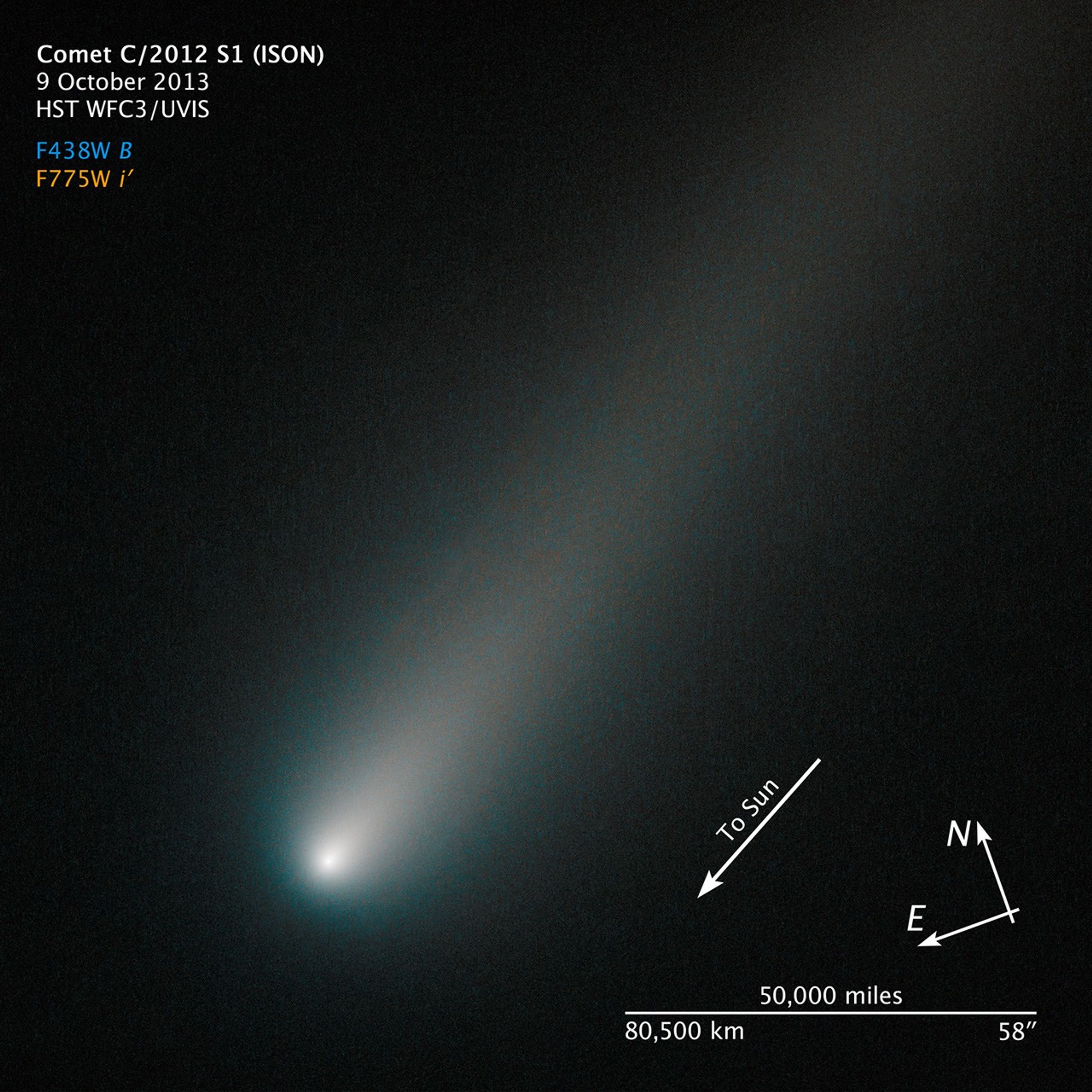1 min read
Incoming Comet ISON Appears Intact to NASA’s Hubble

A new image of the sunward plunging Comet ISON suggests that the comet is intact despite some predictions that the fragile icy nucleus might disintegrate as the Sun warms it. The comet will pass closest to the Sun on November 28.
In this NASA Hubble Space Telescope image taken on October 9, the comet's solid nucleus is unresolved because it is so small. If the nucleus broke apart then Hubble would have likely seen evidence for multiple fragments.
Moreover, the coma or head surrounding the comet's nucleus is symmetric and smooth. This would probably not be the case if clusters of smaller fragments were flying along. A polar jet of dust first seen in Hubble images taken in April is no longer visible and may have turned off.
This color composite image was assembled using two filters. The comet's coma appears cyan, a greenish-blue color due to gas, while the tail is reddish due to dust streaming off the nucleus. The tail forms as dust particles are pushed away from the nucleus by the pressure of sunlight. The comet was inside Mars' orbit and 177 million miles from Earth when photographed. Comet ISON is predicted to make its closest approach to Earth on December 26, at a distance of 39.9 million miles.
About the Object
- DistanceDistanceThe physical distance from Earth to the astronomical object. Distances within our solar system are usually measured in Astronomical Units (AU). Distances between stars are usually measured in light-years. Interstellar distances can also be measured in parsecs.At the time of the Hubble observations on October 9, 2013, the comet was 1.49 astronomical units (139 million miles) from the Sun. The comet was 1.91 astronomical units (177 million miles) from Earth.
About the Data
- Data DescriptionData DescriptionProposal: A description of the observations, their scientific justification, and the links to the data available in the science archive.
Science Team: The astronomers who planned the observations and analyzed the data. "PI" refers to the Principal Investigator.The image was created from Hubble data from proposal 13229 by the Hubble Heritage Team, PI: Z. Levay, M. Mutchler, C. Christian, L. Frattare, W. Januszewski, M. Livio, J. Mack, and J. Sokol (STScI/AURA), and K. Noll (NASA/GSFC). High-level science products for these data are available from the MAST archive at http://archive.stsci.edu/prepds/ison. - InstrumentInstrumentThe science instrument used to produce the data.HST>WFC3/UVIS
- Exposure DatesExposure DatesThe date(s) that the telescope made its observations and the total exposure time.October 9, 2013, Exposure Time: 29 minutes
- FiltersFiltersThe camera filters that were used in the science observations.F438W (B) and F775W (i')
- Object NameObject NameA name or catalog number that astronomers use to identify an astronomical object.Comet ISON
- Object DescriptionObject DescriptionThe type of astronomical object.Comet
- Release DateOctober 17, 2013
- Science ReleaseComet ISON Appears Intact
- Credit

This image is a composite of separate exposures acquired by the WFC3/UVIS instrument. Several filters were used to sample various wavelengths. The color results from assigning different hues (colors) to each monochromatic (grayscale) image associated with an individual filter. In this case, the assigned colors are: Blue/green: F438W (B) and Orange: F775W (i')

Share
Details
Claire Andreoli
NASA’s Goddard Space Flight Center
Greenbelt, Maryland
claire.andreoli@nasa.gov































